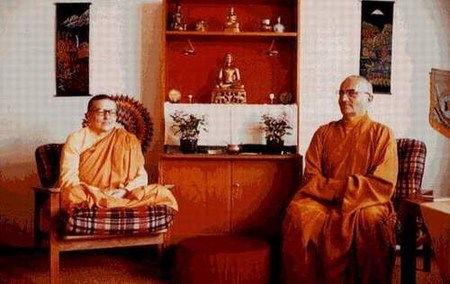- Sweden: A growing interest in Buddhism
- By Rev. Dao Chuan Shakya, O.H.Y.
Along with most western countries, interest in
religion and philosophy of eastern origin is increasing in Sweden by each year.
Firtst out in sweden to display Indian thought were the famous lady
socialist Katja Dahlström (1858 - 1923), and the popular poet Dan Andersson (1888 -
1920).
The Buddhist movement of today, however, began really in the fifties
with the Venerable Dharma Master Tao Wei (Marcel Sirander) and the Venerable Bhikkuni
Amita Nisatta (Ingrid Wagner).
The Rev. Tao Wei began his Buddhist studies in his native town Nice and
within a few years he left France for China where he received ordination as Bhikshu at the
Tse Chia Chan monastery in 1933. There he stayed for five years in study of the Dharma.
At the outburst of the sino-Japanese war he were forced to leave China.
He then returned to Europe and ten years later i came to Sweden where he lived until he
passed away in 1984. He had now disrobed and came as an Upasaka, working at the University
of Gothenburg. At the suggestion of his friend Mahathera Narada he formed the Swedish
Buddhist Society that became the regional center of The World Fellowship of Buddhists.
In 1975 Rev. Tao Wei returned to China - to Hong Kong - where he again
received the Bhikshu ordination. Back in Sweden he formed The Lotus Buddhist order,
following the tradition of The Lotus Buddhist association in Hong Kong. This Order had
members in sweden, England, Israel and France.

Amita Nisatta and Tao Wei
The painting artist Ingrid Wagner and her husband Karl-Henrik went to
India in 1953 to study art and the Buddhist religion. Two years later mrs Wagner were
ordained at Swayambu in nepal, and five months later mr Wagner received ordination as
anagarika. After one year in Sweden Sister Amita - as she was called - were invited to
study in Burma, and during this time anagarika Sugata took over her work in Stockholm.
Upon her return the Anagarika moved to Norway to spread the Dharma there.
Sister Amita gave inspiration to the forming of a society called
'Buddhismens Vänner' (The Friends of Buddhism), that has atracted people from many parts
of Sweden. Her lectures in the Chinese tempelroom at the Ethnographic Museum in Stockholm
bacame quite famous.
In the early seventies Sweden began receiving refugees from different
parts of the world, and out of this rose various ethnic Buddhist groups all over the
country. Today the official number of Buddhists in Sweden is around 8.000 out of a
population of 8 miljons. Of these there are an estimated number of native Buddhists of
2.000. the religion is recognized by the government and special graveyards are offered.
Although there is a couple of them, there is a lack of official
temples, mainly due to lack of funds in the various small cong-regations. The usual
meeting place is an apartment or office room leased for the purpose.
Somewhat beside the traditional Buddhist Orders you'll also find that
organisations such as the Soka Gakkai, the Maitreya cult of Dao and the Fa Lun Gong has
gained a wide range of followers. (Wether or not the latter two can be called Buddhist is
another topic I won't discuss here).
In recent years there has been a growing cooperation between Denmark
and Sweden with resident and visiting monks and teachers, and today you'll find groups
connected to most of the worlds known Buddhist Orders.

The Author